Serie Conozcamos el Audio Vintage (Capítulo 3) [ESP-ENG]
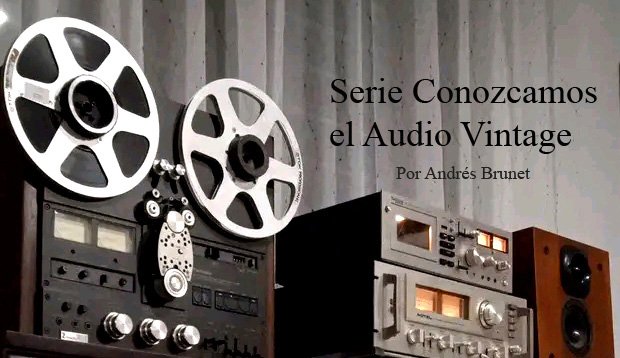
Capítulo 3
Fuentes de Audio: Platos o tornamesas para discos de vinilo
Los platos, también conocidos como tornamesas o como turntables en inglés, es una de las fuentes preferidas por los amantes del Audio Vintage. Es un sistema de reproducción de audio analógico, antes precedido por los gramófonos. Una tecnología que ha sabido mantenerse por mucho tiempo, hasta el siglo actual, donde crece su uso.
Su auge creció cuando se crearon los discos con microsurcos, el disco de larga duración o LP a una velocidad de 33⅓ RPM, y el sencillo a 45 RPM.
Para los audiófilos, escuchar la música que está grabada en un disco de acetato, es algo que dignifica su pasión por el sonido de alta fidelidad. El hecho de hacer ese ritual manual de poner el vinilo, ponerlo en el plato giradisco, y operar el plato totalmente manual por ambas caras, es algo que todo amante del Audio Vintage disfruta con creces. A ello se le suma ese ruído clásico del roce mecánico de la aguja por el surco, llamado scratch, que es el sello que delata a toda reproducción emitida por un plato.
El sonido que deleita nuestros oídos al escuchar un vinilo, es hermoso y nos transporta a épocas pasadas donde el sonido analógico se imponía, llegando con una calidad bastante parecida a la realidad y sin molestias o fatigas auditivas.
Las partes principales de un plato son:
El fonochasis formado por el plato giradiscos donde ponemos el disco de vinilo, el brazo y la cápsula o unidad fonocaptora con su aguja.
Aparte, podemos encontrar los sistemas de regulación de la velocidad, la palanca de elevación del brazo, el botón de antiskating.
La base o plinth que le confiere la estabilidad y es el soporte de toda la estructura.
Internamente, el motor, la parte electrónica y la mecánica.
De su parte posterior generalmente salen 3 cables: el de alimentación AC, la salida del audio estéreo a través de los dos conectores RCA (Radio Corporation of America) que se conectan a la entrada de Phono del Pre amplificador o al Amplificador Integrado, y por último, el cable de tierra.
El plato giradiscos normalmente es de metal y tiene un diámetro de unas 12 o más pulgadas. Se acopla al motor que le proporciona la energía mecánica para que este gire.
La velocidad con la que el motor haga girar el giradiscos ha de ser ajustada.
Es importante también la tapa o su cubierta de plástica, que lo protege del polvo y así logremos el mejor rendimiento en la reproducción.
Los platos de acuerdo al tipo de tracción del motor con el giradiscos pueden ser:
Los que usan ligas, llamados también Belt Drive.
Los que son de tracción directa, sin ligas de goma, también llamados Direct Drive.
De acuerdo al tipo de operatividad pueden ser:
Manuales: La misma persona mueve el brazo con su unidad fonocaptora lo ubica en la pista correspondiente del disco de vinilo, y lo retira después a su posición base de descanso.
Semiautomáticos: cuando se termina la escucha del disco, retorna el brazo fonocaptor automáticamente a su lugar, y se apaga el motor.
Automáticos: Una vez accionado la función de inicio, el brazo se mueve por sí mismo al punto de lectura del disco.
Un plato bueno debe tener peso y un sistema de suspensión adecuado para tener una mejor estabilidad y no se vea tan afectado por las vibraciones internas como externas. De esa manera la cápsula recogerá la información del disco, y no los ruídos parásitos ajenos.
Sistemas más usados para regular la velocidad del giradiscos:
- A través de potenciómetros giratorios stándars o por un control tipo deslizante o slide, llamado también pitch control, los que regulan la velocidad de forma variable, para más o menos revoluciones por minuto.
- A través de una luz estroboscópica:
Los platos que tienen este sistema de regulación, tienen en el borde del plato giradiscos metálico unas hileras de puntoe, que varían de tamaño de acuerdo a las distintas velocidades a las que el plato pueda girar.
En la superficie del plato encontramos el estroboscopio con su luz. Cuando el plato gira a la velocidad fijada y funciona perfecto, las hileras de puntos correspondientes a esa velocidad, deben verse a nuestros ojos, como que los puntitos no se mueven. Si se mueven más lentamente o más rápido, significa que la velocidad de reproducción no es la adecuada y se sentirá la música o más lenta o más rápida. Las velocidades más usadas en las tornamesas son: 45 y 33 RPM.
Relacionado al Brazo:
Los brazos pueden ser recto y curvo en su forma.
Uno recto es proclive al error tangencial, por lo que deben tener el soporte de la cápsula, con una inclinación angular de 70º.
El brazo curvo en forma de "S", se usa para minimizar éste error tangencial, y que el soporte de la cápsula esté más recto respecto al radio del disco.
El brazo en su extremo trasero puede tener distintos tipos de contrapeso, de 2 a 3, que se son usados para equilibrar el peso de la unidad fonocaptora que se encuentra en la otra punta del brazo. Cuando se realiza un buen balance, el brazo se queda en suspensión en el aire, en el centro a nivel, ni se queda arriba, ni en posición baja.
Función de Anti-skating
Su función es controlar la fuerza lateral para que mantenga a la cápsula sin que se mueva a la parte exterior del disco, de manera que el vinilo esté girando y la aguja se quede en la misma posición donde la dejamos.
Cápsula Fonocaptora y aguja:
Es una parte de gran importancia, para que logremos tener un sonido analógico final con buena calidad. Es un transductor que convierte la vibración mecánica a impulsos eléctricos. La aguja de la cápsula o unidad, es la que recorre los surcos del vinilo, y monta en el cantilever.
En otro post, hablaremos más detalles sobre la cápsula, los tipos que existen; los distintos tipos de agujas, etc (continuará)
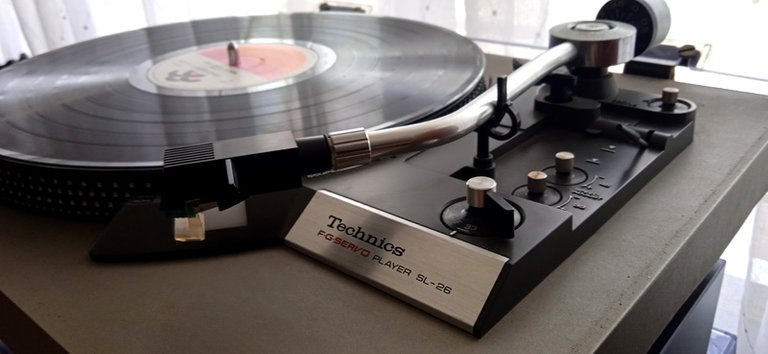
[Plato Belt Drive.Technics SL-26, 1976/Belt Drive Turntable.Technics SL-26, 1976]
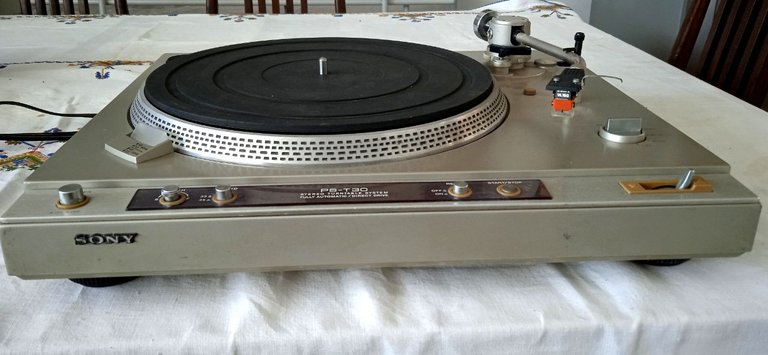
[Plato Direct Drive. Sony PS-T30, 1978/Direct Drive Turntable. Sony PS-T30, 1978]
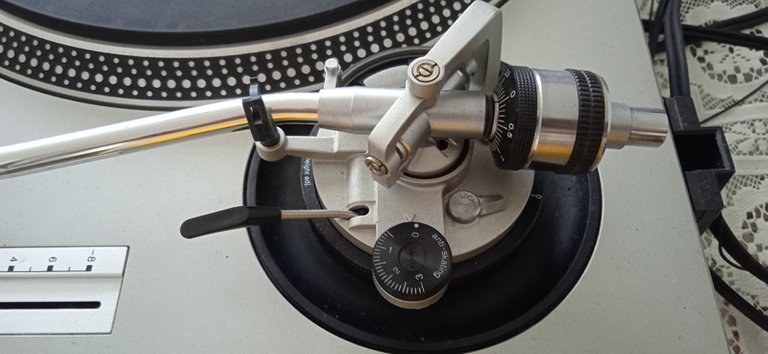
[Contrapesos, elevador del brazo, botón anti skating. Plato Direct Drive. Technics SL-1200 MK2, 1979/Counterweights, tone arm elevator, anti skating button. Direct Drive Turntable. Technics SL-1200 MK2, 1979]

[Cápsula fonocaptora. Plato Belt Drive. Pioneer PL-112D, 1976/Cartridge. Belt Drive Turntable. Pioneer PL-112D, 1976]
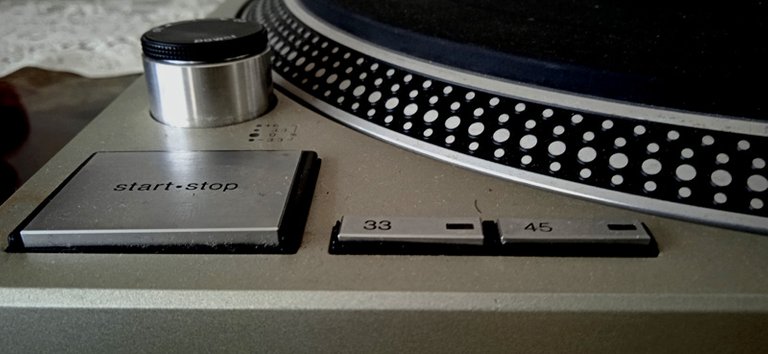
[De alante hacia atrás: Botón de encendido, ajuste de velocidad en 33 y 45 RPM, giradiscos con puntos y el estroboscopio a la izquierda. Plato Direct Drive. Technics SL-1200 MK2, 1979/Front to back: Power button, speed adjustment in 33 and 45 RPM, platter with dots and left strobe light . Direct Drive Turntable. Technics SL-1200 MK2, 1979]
Chapter 3
Audio Sources: Turntables for vinyl records
The turntables, also known as turntables in English, is one of the favorite sources for Vintage Audio lovers. It is an analog audio reproduction system, formerly preceded by gramophones. A technology that has been able to maintain itself for a long time, until the current century, where its use is growing.
Its boom grew when records with microgrooves were created, the long-playing record or LP at a speed of 33⅓ RPM, and the single at 45 RPM.
For audiophiles, listening to music that is recorded on an acetate disc is something that dignifies their passion for high-fidelity sound. The fact of doing that manual ritual of putting the vinyl, putting it on the turntable, and operating the turntable completely manually on both sides, is something that every Vintage Audio lover enjoys with pleasure. Added to this is that classic noise of the mechanical rubbing of the needle along the groove, called scratch, which is the hallmark of any reproduction issued by a turntable.
The sound that delights our ears when listening to a vinyl, is beautiful and transports us to past times where the analog sound was imposed, arriving with a quality quite close to reality and without discomfort or auditory fatigue.
The main parts of a turntable are:
The phonochasis formed by the turntable where we put the vinyl record, the tone arm and the cartridge with its stylus.
Besides, we can find the speed regulation systems, the tone arm elevation lever, the antiskating button.
The base or plinth that confers stability and is the support of the whole structure.
Internally, the motor, the electronic and mechanical parts.
From the back of the turntable there are usually 3 cables: the AC power cable, the stereo audio output through the two RCA (Radio Corporation of America) connectors that connect to the Phono input of the pre-amplifier or the integrated amplifier, and finally the ground cable.
The turntable is usually made of metal and has a diameter of about 12 or more inches. It is coupled to the motor which provides the mechanical power for the turntable to rotate.
The speed at which the motor spins the turntable has to be adjusted.
It is also important the cover or its plastic cover, which protects it from dust and thus we achieve the best performance in the reproduction.
The turntables according to the type of traction of the motor with the platter can be:
Those using rubber bands, also called Belt Drive.
Those with direct drive, without rubber bands, also called Direct Drive.
According to the type of operation they can be:
Manual: The same person moves the arm with its cartridge, places it on the corresponding track of the vinyl record, and then removes it to its rest position.
Semi-automatic: When listening to the record is finished, the tone arm returns automatically to its place, and the motor is turned off.
Automatic: Once the start function is activated, the tone arm moves by itself to the reading point of the disc.
A good platter should have weight and a proper suspension system for better stability and not be affected as much by internal as external vibrations. That way the capsule will pick up the information from the record, and not the extraneous parasitic noises.
Most used systems to regulate the speed of the turntable:
- Through standard rotary potentiometers or by a slide type control, also called pitch control, which regulate the speed in a variable way, for more or less revolutions per minute.
- Through a strobe light:
The turntables that have this regulation system have on the edge of the metal turntable some rows of dots, which vary in size according to the different speeds at which the turntable can rotate.
On the surface of the turntable we find the stroboscope with its light. When the coil rotates at the set speed and works perfectly, the rows of dots corresponding to that speed should look to our eyes as if the dots are not moving. If they move slower or faster, it means that the playback speed is not right and the music will feel slower or faster. The most commonly used speeds on turntables are: 45 and 33 RPM.
Related to the Tone Arm:
Tone Arms can be straight and curved in shape.
A straight one is prone to tangential error, so they must have the capsule support, with an angular inclination of 70º.
The curved "S" shaped arm is used to minimize this tangential error, and the capsule or cartridge support is straighter with respect to the disk radius.
The rear end of the arm can have different types of counterweights, from 2 to 3, which are used to balance the weight of the cartridge at the other end of the tone arm. When well balanced, the tone arm remains suspended in the air, level in the center, neither up nor down.
Anti-skating function
Its function is to control the lateral force to keep the cartridge from moving to the outside of the record, so that the vinyl is spinning and the stylus stays in the same position where we left it.
Cartridge and stylus:
It is a part of great importance, so that we achieve to have a final analog sound with good quality. It is a transducer that converts the mechanical vibration to electrical impulses. The stylus of the cartridge, is the one that runs along the grooves of the vinyl, and mounts on the cantilever.
In another post, we will talk more details about the cartridge, the types that exist; the different types of stylus, etc (to be continued).
Gracias por leer/Thank you for reading
Bienvenidos sus comentarios/Welcome your comments
¡Saludos infinitos!/Infinite greetings!
Capítulo anterior/Previous chapter
Fotos de mis equipos de audio tomadas con un celular Xiaomi redmi 9A/Photos of my audio equipment taken with Xiaomi redmi 9A cell phone.
Andrés Antonio Brunet Mikuskiewicz
Hive: @abrunet
https://twitter.com/AndresBrunetMD/status/1544767738048135170
The rewards earned on this comment will go directly to the people sharing the post on Twitter as long as they are registered with @poshtoken. Sign up at https://hiveposh.com.
Dear @abrunet, we need your help!
The Hivebuzz proposal already got important support from the community. However, it lost its funding a few days ago when the HBD stabilizer proposal rose above it.
May we ask you to support it so our team can continue its work?
You can do it on Peakd, Ecency, Hive.blog or using HiveSigner.
https://peakd.com/me/proposals/199
All votes are helpful and yours will be much appreciated.
Thank you!
Yo tengo una colección bastante monumental de aparatos vintage heredados de mi padre, y montones de discos mas para disfrutar de ellos, me encanta el estilo vintage y casi cualquier cosa que posea un legado histórico